[English] 日本語
 Yorodumi
Yorodumi- PDB-5lzp: Binding of the C-terminal GQYL motif of the bacterial proteasome ... -
+ Open data
Open data
- Basic information
Basic information
| Entry | Database: PDB / ID: 5lzp | ||||||
|---|---|---|---|---|---|---|---|
| Title | Binding of the C-terminal GQYL motif of the bacterial proteasome activator Bpa to the 20S proteasome | ||||||
 Components Components |
| ||||||
 Keywords Keywords |  HYDROLASE / HYDROLASE /  Proteasome / Proteasome activator / Proteasome / Proteasome activator /  protein degradation / protein degradation /  complex complex | ||||||
| Function / homology |  Function and homology information Function and homology informationsymbiont-mediated perturbation of host defenses / proteasome accessory complex / positive regulation of proteasomal protein catabolic process /  zymogen binding / zymogen binding /  proteasome binding / proteasome binding /  proteasome endopeptidase complex / proteasome core complex, beta-subunit complex / proteasome core complex, alpha-subunit complex / threonine-type endopeptidase activity / peptidoglycan-based cell wall ...symbiont-mediated perturbation of host defenses / proteasome accessory complex / positive regulation of proteasomal protein catabolic process / proteasome endopeptidase complex / proteasome core complex, beta-subunit complex / proteasome core complex, alpha-subunit complex / threonine-type endopeptidase activity / peptidoglycan-based cell wall ...symbiont-mediated perturbation of host defenses / proteasome accessory complex / positive regulation of proteasomal protein catabolic process /  zymogen binding / zymogen binding /  proteasome binding / proteasome binding /  proteasome endopeptidase complex / proteasome core complex, beta-subunit complex / proteasome core complex, alpha-subunit complex / threonine-type endopeptidase activity / peptidoglycan-based cell wall / proteolysis involved in protein catabolic process / proteasomal protein catabolic process / modification-dependent protein catabolic process / protein homooligomerization / extracellular region / proteasome endopeptidase complex / proteasome core complex, beta-subunit complex / proteasome core complex, alpha-subunit complex / threonine-type endopeptidase activity / peptidoglycan-based cell wall / proteolysis involved in protein catabolic process / proteasomal protein catabolic process / modification-dependent protein catabolic process / protein homooligomerization / extracellular region /  plasma membrane / plasma membrane /  cytoplasm cytoplasmSimilarity search - Function | ||||||
| Biological species |   Mycobacterium tuberculosis H37Rv (bacteria) Mycobacterium tuberculosis H37Rv (bacteria) | ||||||
| Method |  ELECTRON MICROSCOPY / ELECTRON MICROSCOPY /  single particle reconstruction / single particle reconstruction /  cryo EM / Resolution: 3.5 Å cryo EM / Resolution: 3.5 Å | ||||||
 Authors Authors | Bolten, M. / Delley, C.L. / Leibundgut, M. / Boehringer, D. / Ban, N. / Weber-Ban, E. | ||||||
 Citation Citation |  Journal: Structure / Year: 2016 Journal: Structure / Year: 2016Title: Structural Analysis of the Bacterial Proteasome Activator Bpa in Complex with the 20S Proteasome. Authors: Marcel Bolten / Cyrille L Delley / Marc Leibundgut / Daniel Boehringer / Nenad Ban / Eilika Weber-Ban /  Abstract: Mycobacterium tuberculosis harbors proteasomes that recruit substrates for degradation through an ubiquitin-like modification pathway. Recently, a non-ATPase activator termed Bpa (bacterial ...Mycobacterium tuberculosis harbors proteasomes that recruit substrates for degradation through an ubiquitin-like modification pathway. Recently, a non-ATPase activator termed Bpa (bacterial proteasome activator) was shown to support an alternate proteasomal degradation pathway. Here, we present the cryo-electron microscopy (cryo-EM) structure of Bpa in complex with the 20S core particle (CP). For docking into the cryo-EM density, we solved the X-ray structure of Bpa, showing that it forms tight four-helix bundles arranged into a 12-membered ring with a 40 Å wide central pore and the C-terminal helix of each protomer protruding from the ring. The Bpa model was fitted into the cryo-EM map of the Bpa-CP complex, revealing its architecture and striking symmetry mismatch. The Bpa-CP interface was resolved to 3.5 Å, showing the interactions between the C-terminal GQYL motif of Bpa and the proteasome α-rings. This docking mode is related to the one observed for eukaryotic activators with features specific to the bacterial complex. | ||||||
| History |
|
- Structure visualization
Structure visualization
| Movie |
 Movie viewer Movie viewer |
|---|---|
| Structure viewer | Molecule:  Molmil Molmil Jmol/JSmol Jmol/JSmol |
- Downloads & links
Downloads & links
- Download
Download
| PDBx/mmCIF format |  5lzp.cif.gz 5lzp.cif.gz | 1.1 MB | Display |  PDBx/mmCIF format PDBx/mmCIF format |
|---|---|---|---|---|
| PDB format |  pdb5lzp.ent.gz pdb5lzp.ent.gz | 957 KB | Display |  PDB format PDB format |
| PDBx/mmJSON format |  5lzp.json.gz 5lzp.json.gz | Tree view |  PDBx/mmJSON format PDBx/mmJSON format | |
| Others |  Other downloads Other downloads |
-Validation report
| Arichive directory |  https://data.pdbj.org/pub/pdb/validation_reports/lz/5lzp https://data.pdbj.org/pub/pdb/validation_reports/lz/5lzp ftp://data.pdbj.org/pub/pdb/validation_reports/lz/5lzp ftp://data.pdbj.org/pub/pdb/validation_reports/lz/5lzp | HTTPS FTP |
|---|
-Related structure data
| Related structure data |  4128MC  4127C  5lfjC 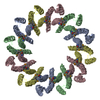 5lfpC 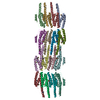 5lfqC M: map data used to model this data C: citing same article ( |
|---|---|
| Similar structure data |
- Links
Links
- Assembly
Assembly
| Deposited unit | 
|
|---|---|
| 1 |
|
- Components
Components
| #1: Protein |  / 20S proteasome alpha subunit / Proteasome core protein PrcA / 20S proteasome alpha subunit / Proteasome core protein PrcAMass: 26024.971 Da / Num. of mol.: 14 / Mutation: M1_I7del Source method: isolated from a genetically manipulated source Source: (gene. exp.)   Mycobacterium tuberculosis H37Rv (bacteria) Mycobacterium tuberculosis H37Rv (bacteria)Gene: prcA, Rv2109c / Production host:   Escherichia coli BL21(DE3) (bacteria) Escherichia coli BL21(DE3) (bacteria)References: UniProt: P9WHU1,  proteasome endopeptidase complex proteasome endopeptidase complex#2: Protein |  Proteasome accessory factor E Proteasome accessory factor EMass: 19792.113 Da / Num. of mol.: 7 Source method: isolated from a genetically manipulated source Source: (gene. exp.)   Mycobacterium tuberculosis H37Rv (bacteria) Mycobacterium tuberculosis H37Rv (bacteria)Gene: bpa, Rv3780, MTCY13D12.14 / Production host:   Escherichia coli BL21(DE3) (bacteria) / References: UniProt: P9WKX3 Escherichia coli BL21(DE3) (bacteria) / References: UniProt: P9WKX3#3: Protein |  / 20S proteasome beta subunit / Proteasome core protein PrcB / 20S proteasome beta subunit / Proteasome core protein PrcBMass: 25457.504 Da / Num. of mol.: 14 / Mutation: T1A Source method: isolated from a genetically manipulated source Source: (gene. exp.)   Mycobacterium tuberculosis H37Rv (bacteria) Mycobacterium tuberculosis H37Rv (bacteria)Gene: prcB, Rv2110c / Production host:   Escherichia coli BL21(DE3) (bacteria) Escherichia coli BL21(DE3) (bacteria)References: UniProt: P9WHT9,  proteasome endopeptidase complex proteasome endopeptidase complex |
|---|
-Experimental details
-Experiment
| Experiment | Method:  ELECTRON MICROSCOPY ELECTRON MICROSCOPY |
|---|---|
| EM experiment | Aggregation state: PARTICLE / 3D reconstruction method:  single particle reconstruction single particle reconstruction |
- Sample preparation
Sample preparation
| Component | Name: proteasome in complex with bacterial proteasome activator Type: COMPLEX / Entity ID: #1-#7 / Source: MULTIPLE SOURCES | |||||||||||||||
|---|---|---|---|---|---|---|---|---|---|---|---|---|---|---|---|---|
| Molecular weight | Value: 0.93 MDa / Experimental value: NO | |||||||||||||||
| Source (natural) | Organism:   Mycobacterium tuberculosis H37Rv (bacteria) / Cellular location: cytoplasm Mycobacterium tuberculosis H37Rv (bacteria) / Cellular location: cytoplasm | |||||||||||||||
| Source (recombinant) | Organism:   Escherichia coli BL21(DE3) (bacteria) Escherichia coli BL21(DE3) (bacteria) | |||||||||||||||
| Buffer solution | pH: 7.5 | |||||||||||||||
| Buffer component |
| |||||||||||||||
| Specimen | Conc.: 0.102 mg/ml / Embedding applied: NO / Shadowing applied: NO / Staining applied : NO / Vitrification applied : NO / Vitrification applied : YES : YES | |||||||||||||||
| Specimen support | Details: Quantifoil R 2/2 with an additional thin carbon layer Grid material: COPPER / Grid mesh size: 400 divisions/in. / Grid type: Quantifoil R2/2 | |||||||||||||||
Vitrification | Instrument: FEI VITROBOT MARK I / Cryogen name: ETHANE / Humidity: 95 % / Chamber temperature: 280.5 K |
- Electron microscopy imaging
Electron microscopy imaging
| Experimental equipment |  Model: Titan Krios / Image courtesy: FEI Company |
|---|---|
| Microscopy | Model: FEI TITAN KRIOS |
| Electron gun | Electron source : :  FIELD EMISSION GUN / Accelerating voltage: 300 kV / Illumination mode: FLOOD BEAM FIELD EMISSION GUN / Accelerating voltage: 300 kV / Illumination mode: FLOOD BEAM |
| Electron lens | Mode: BRIGHT FIELD Bright-field microscopy / Nominal magnification: 59000 X / Calibrated magnification: 100000 X / Nominal defocus max: 3600 nm / Nominal defocus min: 1000 nm / Cs Bright-field microscopy / Nominal magnification: 59000 X / Calibrated magnification: 100000 X / Nominal defocus max: 3600 nm / Nominal defocus min: 1000 nm / Cs : 2.7 mm : 2.7 mm |
| Specimen holder | Cryogen: NITROGEN / Specimen holder model: FEI TITAN KRIOS AUTOGRID HOLDER |
| Image recording | Electron dose: 25 e/Å2 / Detector mode: INTEGRATING / Film or detector model: FEI FALCON II (4k x 4k) / Num. of grids imaged: 1 Details: Drift corrected in post-processing. 4 images per hole. |
| Image scans | Sampling size: 14 µm / Movie frames/image: 7 |
- Processing
Processing
| Software | Name: PHENIX / Version: (1.10_2155: ???) / Classification: refinement | |||||||||||||||||||||||||||||||||||||||||||||
|---|---|---|---|---|---|---|---|---|---|---|---|---|---|---|---|---|---|---|---|---|---|---|---|---|---|---|---|---|---|---|---|---|---|---|---|---|---|---|---|---|---|---|---|---|---|---|
| EM software |
| |||||||||||||||||||||||||||||||||||||||||||||
CTF correction | Type: PHASE FLIPPING AND AMPLITUDE CORRECTION | |||||||||||||||||||||||||||||||||||||||||||||
| Symmetry | Point symmetry : C7 (7 fold cyclic : C7 (7 fold cyclic ) ) | |||||||||||||||||||||||||||||||||||||||||||||
3D reconstruction | Resolution: 3.5 Å / Resolution method: FSC 0.143 CUT-OFF / Num. of particles: 48799 / Symmetry type: POINT | |||||||||||||||||||||||||||||||||||||||||||||
| Atomic model building | Protocol: RIGID BODY FIT | |||||||||||||||||||||||||||||||||||||||||||||
| Refinement | Resolution: 3.45→403.2 Å / SU ML: 0.73 / σ(F): 1.99 / Phase error: 34.64 / Stereochemistry target values: MLHL
| |||||||||||||||||||||||||||||||||||||||||||||
| Solvent computation | Shrinkage radii: 0.9 Å / VDW probe radii: 1.11 Å / Solvent model: FLAT BULK SOLVENT MODEL | |||||||||||||||||||||||||||||||||||||||||||||
| Refine LS restraints |
|
 Movie
Movie Controller
Controller



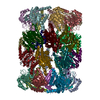
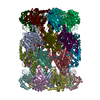



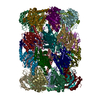
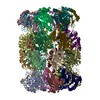

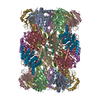
 PDBj
PDBj



